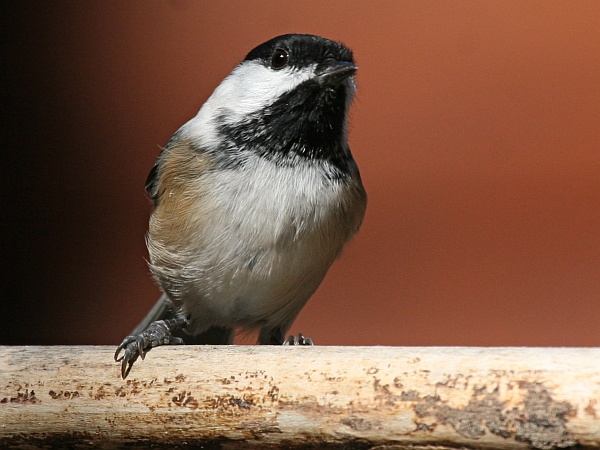
22 January 2009
Most birders east of the Rocky Mountains never have to ask this question, but along an east-west line that surrounds the southwest corner of Pennsylvania it’s an important question indeed. It’s one I often ask myself as I travel around the region.
Two species of chickadees live here, black-capped and Carolina, and they look a lot alike.
Because chickadees are non-migratory you can usually be certain of the species based on your location in eastern North America: black-caps live in the north, Carolinas live south. But around here you have to think about the line. Are you on the black-capped or Carolina side? And you have to check field marks.
Black-capped chickadees (Poecile atricapillus) live in the Laurel Highlands and north of Pittsburgh. North of the line you can be fairly certain you are seeing a black-capped. Check for :
- A white line on each wing that looks like an inverted hockey stick
- Edge of the black bib is a ragged line
- Sides are olive
- Song is two-notes (fee-bee)
- Call is a slow distinct “chick-a-dee, chick-a-dee-dee”
- Birds are larger the further north you go. In my experience a black-capped in Maine is larger than one in PA.
Carolina chickadees (Poecile carolinensis) live in Allegheny County and southward. They have:
- No hockey stick shape on wings
- Edge of the black bib is more distinct, not ragged
- Less olive on their sides
- Song is four notes (fee-bee-fee-bay). Song is the best field mark except in the hybrid zone.
- “Chick-a-dee-dee-dee” call is faster
- Smaller than black-capped with proportionally shorter tail.
Notice how these descriptions are comparatives of “more this” and “less that.” Not very helpful since you usually won’t find the two side by side, not even at the black-capped/Carolina dividing line.
The border between the black-capped and Carolina ranges is fluid. The two species can expand or contract their ranges, sing each others’ songs, and hybridize. At the border the only way to tell them apart is by a DNA test.
So have a little patience with those of us who live on the chickadee border. If we say we’ve seen a “chickadee species” it’s because we left our DNA kits at home. 😉
(photo of a black-capped chickadee by Chuck Tague)
Our yard was the first confirmed Carolina Chickadee back on March 27th, 2007 on my 50th Birthday for an Indiana County record…I had heard it for a while, but my birding mentor, Margaret Higbee came and I didn’t tell her.. ( I was weeding and watching her when she came.)She got the Chickadee as soon as she got out the car…she came running up the ramp so excited…. I just smiled and she said do you know what I just saw and heard? I already knew it was a Carolina Chickadee…Nice BD present…a new yard bird #153 for our new yard and a visit from a birding friend…Now I hear and see the Chickadees and we do have hybrids here(they nest here)…so I am trying to get a definite photo of the Carolina…seems they like to stay in the woods more than the Black-capped….they are one of my favorite birds..Chick-a-dee-dee-dee…
(Sorry I don’t have the DNA kit either…would be nice to have some banded to see exactly what we do have flying in the yard.)
My mother has lived both north and south of the chickadee line and reminded me that the black-capped chickadees seem much more tame than carolina chickadees. This seems true to me because people tell me about chickadees that will eat out of their hands – but the stories always seem to come from the black-capped side of the chickadee border.
Anyone have any experience hand-feeding chickadees? What species?
I’m clearly in Black-capped territory here but would love to be tested on the line between the two to tell them apart. Nice post.